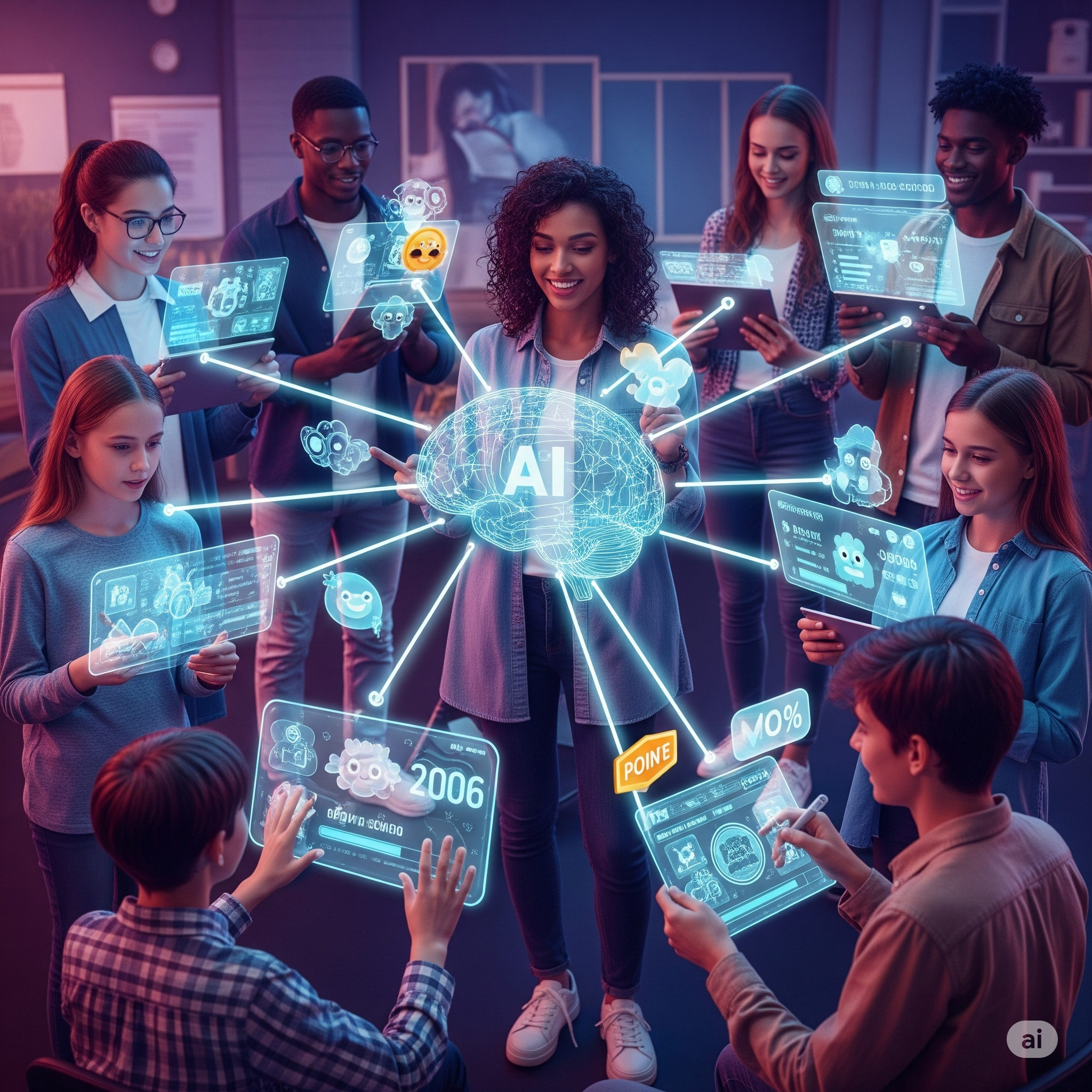In an increasingly digitized world, capturing and sustaining attention has become a true art form. For educators, the challenge is particularly acute: how do we make learning not just informative, but genuinely captivating and sticky? The answer lies in a powerful fusion of two transformative forces: gamification and Artificial Intelligence (AI). The integration of AI gamification education is ushering in a new era of learning experiences that are not only effective but also deeply engaging, leveraging the innate human desire for play, challenge, and reward to foster deeper understanding and long-term retention.
Traditional classrooms, while foundational, often struggle to compete with the immersive and interactive experiences that define modern entertainment. By strategically infusing game-like elements into educational contexts, gamification transforms mundane tasks into exciting quests. When combined with the adaptive and personalized power of AI, this synergy creates an unparalleled learning environment. AI gamification education moves beyond simple points and badges, leveraging intelligent algorithms to tailor challenges, provide real-time feedback, and personalize learning pathways, ensuring that every student is challenged at just the right level, ultimately boosting engaging learning AI to new heights.
The Engagement Gap: Why Traditional Methods Fall Short
For centuries, education has largely relied on rote memorization, lectures, and standardized testing. While these methods have their place, they often fail to ignite curiosity, foster intrinsic motivation, or cater to diverse learning styles. In an age where digital entertainment provides instant gratification and immersive experiences, static textbooks and passive learning can feel tedious and disconnected for many students. This often leads to disengagement, a lack of sustained effort, and ultimately, suboptimal learning outcomes.
The challenge isn’t just about delivering content; it’s about making content resonate. Students are more likely to retain information when they are actively involved, feel a sense of accomplishment, and are motivated by more than just grades. This is where gamification offers a powerful solution, injecting elements of fun, challenge, and progress into the learning journey. However, generic gamification can still fall short if it isn’t adaptive. The real magic happens when AI steps in, personalizing the game-like experience to each individual, turning static activities into dynamic, responsive challenges. This is the promise of AI gamification education.
The Synergy: How AI Elevates Gamification in Education
Gamification, at its core, involves applying game-design elements and game principles in non-game contexts. This includes points, badges, leaderboards, levels, quests, narratives, and immediate feedback. While effective on its own, traditional gamification can still be generic. This is where AI truly unlocks its potential, transforming static game mechanics into dynamic, personalized, and highly effective learning tools.
AI gamification education operates by:
- Personalizing Challenges: AI algorithms analyze a student’s performance, strengths, and weaknesses to dynamically adjust the difficulty and type of challenges presented. If a student is struggling with a particular concept, the AI might offer a simpler “mini-game” to reinforce it. If they are excelling, it might unlock a more complex “quest” that requires deeper application of knowledge. This prevents boredom and frustration, leading to sustained engaging learning AI.
- Adaptive Feedback and Rewards: Beyond simple “correct” or “incorrect,” AI can provide nuanced, real-time feedback that explains why an answer was wrong and guides the student towards the correct solution. Rewards (points, badges, virtual currency) can also be personalized based on effort, progress, or mastery, making them more meaningful to the individual.
- Dynamic Storytelling and Progression: AI can generate adaptive narratives or learning paths that evolve based on student choices and performance. Imagine a history game where the branching storyline changes depending on which historical decisions the student makes, requiring them to research and understand different outcomes.
AI gamification education
- Identifying Engagement Patterns: AI can monitor student interaction patterns, time spent on tasks, and even emotional cues (if sensor data is available) to detect signs of disengagement or frustration. The system can then intervene by suggesting a break, offering a different type of challenge, or adapting the content to re-capture attention, fostering continuous engaging learning AI.
- Peer Recommendation and Collaboration: AI can analyze student profiles and performance data to intelligently recommend peers for collaborative challenges or study groups, fostering social learning and healthy competition within a gamified environment.
- Optimizing Game Mechanics: Through continuous data analysis, AI can identify which game mechanics (e.g., specific types of badges, leaderboard structures, competitive elements) are most effective for different types of learners and optimize the gamified experience over time to maximize engagement and learning outcomes.
This intelligent adaptation is what elevates AI gamification education beyond a mere gimmick, turning it into a powerful pedagogical approach.
Real-World Impact: Gamification & AI in Action
The fusion of AI and gamification is already producing tangible results in various educational and training contexts.
Duolingo, the popular language learning app, is a prime example of successful AI gamification education. It uses a highly gamified approach with points, streaks, levels, and competitive leaderboards. Its AI algorithms analyze user performance to determine which vocabulary words or grammar concepts a user needs more practice with, dynamically adjusting lessons and exercises. This adaptive gamification keeps learners motivated and coming back daily, leading to impressive language acquisition rates.
Prodigy Education, an adaptive math platform, also harnesses AI gamification education. Students play a fantasy role-playing game where solving math problems helps them cast spells, battle monsters, and explore new worlds. The AI engine behind Prodigy constantly adjusts the math problems to match the student’s learning level and curriculum, ensuring they are always challenged appropriately. This immersive gamified experience has made math learning fun and effective for millions of students.
Case Study: Revolutionizing Corporate Training with Gamified AI
“InnovateTech Solutions,” a global software development company, faced a persistent challenge with its mandatory compliance and new software training. Employees found traditional e-learning modules boring and disengaging, leading to low completion rates and poor knowledge retention. This posed a significant risk for compliance and slowed down the adoption of crucial new tools.
To combat this, InnovateTech partnered with a specialized learning platform to implement an AI gamification education system for its internal training. The platform transformed compliance modules into interactive “missions” and software training into “skill quests.” Here’s how the engaging learning AI worked:
- Personalized Missions: The AI first assessed each employee’s existing knowledge and role. It then assigned personalized “missions” (training modules) with varying difficulty levels and content focus. For example, a senior developer would receive different challenges than a new sales associate.
- Adaptive Challenges & Rewards: As employees progressed through missions, the AI dynamically adjusted the difficulty of quizzes and simulations based on their performance. Correct answers earned “innovation points” and “mastery badges.” Struggling users would receive immediate, AI-driven feedback and additional practice “mini-games” to reinforce concepts. Leaderboards fostered friendly competition among teams and departments.
- Real-time Progress Tracking: Managers and employees could track progress on interactive dashboards, seeing unlocked “achievements” and overall “skill mastery.” The AI also identified employees who were disengaging and triggered personalized nudges or recommendations for different learning formats.
The outcome was remarkable. InnovateTech saw a 60% increase in training completion rates and a 35% improvement in knowledge retention compared to traditional methods. Employees reported finding the training “fun” and “addictive,” leading to higher satisfaction and faster adoption of new software. This real-world application clearly demonstrated the power of AI gamification education in transforming corporate learning outcomes and fostering a culture of continuous development.
The Business of Engagement: AI Beyond Education
The principles of using AI to drive engagement through gamification are not exclusive to education. Businesses across various sectors are leveraging these same strategies to drive desired behaviors, increase customer loyalty, and boost profitability.
Consider the health and wellness industry. Companies developing fitness apps often employ AI gamification education techniques, though they might call it AI for fitness. These apps use AI to personalize workout regimens, set achievable goals, and track progress. Users earn “points” for completed exercises, “badges” for hitting milestones (e.g., running a certain distance), and compete on “leaderboards” with friends. The AI dynamically adjusts the workout difficulty based on performance and even provides encouraging feedback, much like an intelligent coach. This gamified approach keeps users motivated and engaged with their fitness goals, demonstrating how AI can drive sustained participation in non-educational contexts.
Another example is in retail loyalty programs. AI analyzes customer purchasing history and preferences to offer personalized “challenges” or “quests” (e.g., “Buy three different coffee flavors this month and earn double points!”). Completing these challenges earns customers points, discounts, or exclusive access, driving repeat purchases and strengthening brand loyalty. This clearly shows how engaging learning AI translates into engaging customer experiences that directly impact business growth.
Powerful AI Tools for Gamified Learning Platforms
The landscape of tools enabling AI gamification education is expanding, offering diverse capabilities for educators and developers.
- Sana Labs: (https://www.sana.ai/) Sana combines adaptive learning with AI to create personalized training experiences. Its AI anticipates learning needs, adjusting content and difficulty in real-time, making it ideal for gamified modules that adapt to individual skill gaps and achievements.
- Classcraft: (https://www.classcraft.com/) This platform transforms classroom management and learning into a role-playing game. While it offers a strong gamification framework, its newer AI features enhance the personalization of student experiences, making it a robust example of AI gamification education.
- Duolingo: (https://www.duolingo.com/) As discussed, Duolingo masterfully blends AI with gamification for language learning. Its use of streaks, points, and adaptive challenges, now enhanced with generative AI for conversational practice, sets a high bar for engaging learning AI.
- 360Learning: (https://360learning.com/) This collaborative learning platform uses AI to automate quiz creation and moderate group discussions, supporting gamified team-based challenges and peer interaction. Its AI capabilities help create a seamless and impactful gamified experience.
- ChatGPT (by OpenAI): (https://chat.openai.com/) While a general-purpose AI, ChatGPT can be a powerful underlying tool for creating gamified learning content. Educators can use it to brainstorm game scenarios, generate trivia questions, write dialogue for character interactions, or even help design simple interactive quizzes that form part of a larger gamified experience.
- Quizizz: (https://quizizz.com/) An engaging online platform that allows teachers to create and conduct quizzes with gamified elements like power-ups, themes, and competitive modes. While its core gamification is strong, the integration of AI can personalize questions and feedback.
These tools represent a spectrum from fully integrated adaptive gamification platforms to general AI tools that can be leveraged to build and enhance gamified learning experiences.
Beginner-Friendly Workflows for Implementing AI Gamification
For educators eager to incorporate AI gamification education into their teaching, here are some actionable steps and workflows:
- Start with a Clear Learning Objective: Before you “gamify,” define what you want students to learn or achieve. Gamification should enhance, not distract from, the learning goals.
- Identify a Pain Point for Engagement: Pinpoint a specific area where students typically disengage. Is it repetitive practice, long lectures, or complex problem-solving? This is where AI gamification education can make the most impact.
- Choose a Pilot Tool: Begin with an accessible, user-friendly platform that offers both gamification and some level of AI adaptation, such as Quizlet’s adaptive modes or Classcraft for classroom management.
- Introduce Basic Game Elements: Start simple. Implement points for completing assignments, badges for mastering concepts, or a class leaderboard for participation. Observe how students respond.
AI gamification education
- Leverage AI for Personalization: Once comfortable with basic gamification, explore how AI can personalize it. If using an adaptive platform, trust its algorithms to adjust difficulty. If using a generative AI like ChatGPT, prompt it to create differentiated challenges or scenarios based on different student performance levels.
- Provide Timely, AI-Enhanced Feedback: Use AI-powered tools to provide immediate feedback on quizzes or assignments. Explain to students how they can learn from these instant insights to improve their “game” performance.
- Foster a Growth Mindset: Emphasize that in gamified learning, mistakes are opportunities to learn and “level up.” Encourage a mindset where challenges are embraced.
- Gather Feedback and Iterate: Regularly solicit feedback from students on what game elements they find most engaging and effective. Use this feedback, combined with performance data, to refine and improve your AI gamification education strategy over time.
- Ethical Considerations: Ensure transparency about AI’s role. Protect student data and be mindful of potential biases in algorithms that could inadvertently affect student experiences. (Source: McKinsey on AI ethics).
The Future is Playful: AI for All Kinds of Engagement
The profound impact of AI gamification education is a testament to AI’s ability to not only process information but also to understand and influence human behavior. The integration of game mechanics with intelligent adaptation creates a learning environment that is intrinsically motivating, highly responsive, and deeply personal. This isn’t just about making learning “fun”; it’s about making it inherently more effective by tapping into powerful psychological drivers.
From the classroom to corporate training, and even into personal development realms like AI for fitness, the synergy of AI and gamification is proving to be a potent formula for sustained engagement and superior outcomes. As AI continues to advance, we can expect even more sophisticated and seamless integrations, paving the way for a future where learning is not just a necessity but an exhilarating, personalized adventure for every individual.
AI for teachers: AI Tools for Lesson Planning and Assessment
Personalized Learning Paths: The Future of Education with AI
Wellness Redefined: AI Applications for Personalized Fitness and Nutrition



